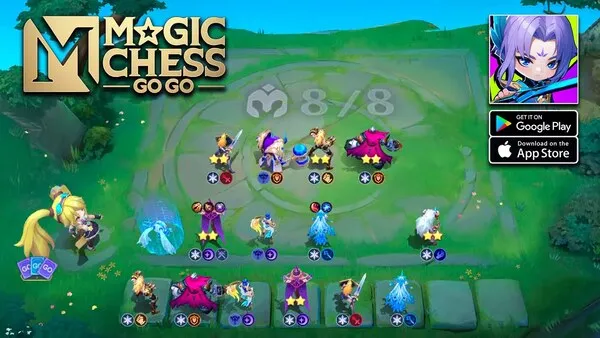Magic Chess GO GO is a game of strategy, chance, and timing. While the flashy late-game synergies and powerful heroes capture the attention of most players, the truth is that victories are often secured much earlier. The key lies in how to manage your early-game economy—the silent engine that fuels your mid-game power spikes and late-game dominance. This guide will break down, step by step, how to build a strong foundation through smart gold management, item usage, and decision-making in the first 10–13 rounds of the game.
1. How to Use Your Starting Gold Effectively
When the game begins, you’re given a small pool of gold and a random selection of units. Many players instinctively spend it all right away, but the smarter approach is restraint.
To master the start, focus on evaluating whether a unit will support a potential synergy or can be resold later to hit an interest threshold. Avoid investing too heavily in units that will be outclassed quickly. The key is not to panic—your goal is to think ahead.
2. How to Decide Between Saving or Spending in Rounds 1–3
In the opening rounds, you’ll face a crucial choice: should you spend your gold to build an early win streak or save it for long-term growth?
If you choose to win streak, you must commit to upgrading units quickly and consistently. If you choose to save, you’ll sacrifice short-term HP to gain stronger scaling through interest. Both methods are viable, but consistency in your choice is critical.
3. How to Pivot in Rounds 4–6
Around rounds 4 to 6, the pressure increases as opponents grow stronger. This is your first major pivot point. You’ll need to decide whether to commit to a synergy path or continue prioritizing gold.
Always pay attention to what others are building. If too many players are chasing the same synergy, it’s smarter to keep your options open, save gold, and wait for the right opportunity. Pivoting effectively here often prevents wasted resources.
4. How to Build Interest for Maximum Growth
Interest is the backbone of economic success. For every 10 gold you save, you gain 1 extra coin per round, up to a maximum of 5. This small mechanic becomes the difference between having enough gold to level up quickly and struggling behind.
Aim to hit milestones of 10, 20, 30, 40, and 50 gold as early as possible. Even selling a weak unit to cross a threshold is usually worth it. Think of interest as compound interest in finance—the earlier you invest, the greater your returns.
5. How to Balance HP Loss and Economy in Rounds 7–9
During these rounds, the cost of a weak board begins to show. If you’ve been saving gold, you might lose more fights. That’s not always a bad thing—it’s part of the plan.
The trick is knowing how much HP you can afford to lose. Stay above 60 HP to keep enough buffer for the mid-game comeback. Avoid panicking and breaking your interest streak, because short-term survival at the cost of economy often leads to long-term defeat.
6. How to Handle Items During the Early Game
Items are as important as gold in the early stages. Equipping a temporary unit with the right item can stabilize your team long enough to maintain your economic strategy.
Don’t wait endlessly for your ideal late-game hero to equip items. Putting defensive gear on a tank or offensive gear on an early carry can save HP while you build up your gold reserves. Think of items as tools for survival, not just for endgame perfection.
7. How to Approach Round 10 Power Spikes
Reaching round 10 is a turning point. By now, you should have at least 20–30 gold if you’ve been managing your economy well. Here’s where you decide: keep building gold or invest to stabilize.
The best approach is balance—spend just enough to prevent excessive HP loss but avoid rolling too much. The players who master this balance often enter the mid-game in the strongest position.
8. How to Stabilize in Rounds 11–13
At this stage, your economic choices will start paying off. With a large pool of gold, you can now level up earlier, roll more aggressively, or chase rare synergies.
But stabilizing isn’t just about units—it’s also about positioning. Smart placement can allow weaker units to defeat stronger boards. Observing opponents and adapting your formation is one of the most underrated skills in Magic Chess GO GO.
9. How Early Economy Snowballs Into Late-Game Strength
By the mid-game, the difference between players who hit 50 gold early and those who didn’t is staggering. The snowball effect of interest means you’ll often have more chances to roll, upgrade, and chase powerful synergies.
Even if you were losing early, the gold you saved can allow you to suddenly flip the game in your favor. This is why economic discipline in the opening rounds is so powerful—it creates opportunities to win even from a disadvantaged start.
10. How to Apply Key Lessons for Every Match
To truly master Magic Chess GO GO, you need to practice economy discipline every game. Here are the essentials to remember:
- Don’t overcommit to weak units in the opening.
- Treat the first 3 rounds as your economic foundation.
- Always aim for multiples of 10 gold for maximum interest.
- Accept controlled HP loss to build long-term strength.
- Adapt to what your opponents are building and adjust your strategy.
Conclusion
Knowing how to manage the early-game economy in Magic Chess GO GO separates casual players from those who consistently reach the top. Every coin saved in the first 10 rounds becomes fuel for explosive power later. By applying these methods—prioritizing interest, balancing HP with savings, and pivoting strategically—you’ll master the art of economic growth and set yourself on the path to victory.

















